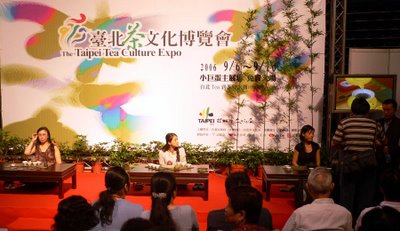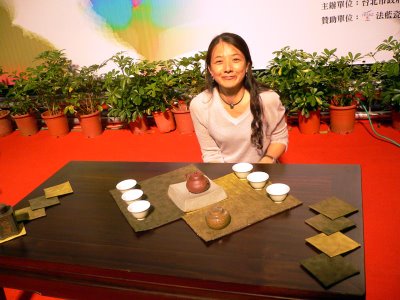In the middle, you then had the local cultural tea associations and this big stage.

That's where Teaparker made a one hour presentation of how to enjoy tea. (It all starts by being calm and focused).
For the occasion, he shared a 1986 Dong Ding Oolong with the public. Three of his students brewed this tea using tea sets they have designed and made themselves with patchwork:



I helped them serving the tea to the many listeners.
At the end of the presentation, Teaparker had a Q&A session. One visitor asked which old Oolong tea is better, the one that is roasted once or the one that is roasted regularly. Teaparker's answer was very typical: it depends. If an Oolong tea that is roasted just once starts to rot because it has absorbed too much humidity, then it should have been roasted again. On the other hand, if the repeated roasting was too strong, then the leaves may become damaged/dead, which is bad too.
Teaparker also gave advice on how to age Oolong. First, choose a good quality Oolong with a long aftertaste. Use a round shaped, glazed jar that you fill completely with the tea (in order to reduce the amount of air). Then close the top tightly: use wax from a candle to seal it airtight. Finally, open it when you feel like it. Each year that passes will bring changes and you don't need to wait a predetermined time.
Of course, the best is to start experimenting with smaller quanitites before moving towards bigger quantities.
Close to the stage there where also some high end tea shops with very elaborate demonstrations like this one:

And towards the end of the expo, there were 2 rows of tea and tea related merchants. Some played the game of the 'cultural' concept of this expo and also displayed their own old tea items like this merchant established in 1841:

Dehua 'blanc de Chine' teapot and cups on the left (17th century).
There were also a water filtering company, one selling a very sweet bamboo water, and several puerh merchants. Well, I ended up just buying a bar of soap made of tea seed oil. This Taiwanese company seems to have adapted the concept of 'Lush', a western soap company, to Chinese ingredients.







4 comments:
As always, I learn so much from each and every article you write.
Question:
About sealing oolong for aging, you / Teaparker said use wax to seal it "airtight". But wax is very porous and so it's not 100% airtight. However, I think for aging we need some air (very miniscule, like oxygen coming in from a healthy cork in the wine bottle over many many years)...if this is the case, then wax is perfect for aging oolong. I just need a clarification, because I'm looking to fill a jar with some good quality wuyi da hong pao for aging purposes. I'd like to do it correctly.
Thank you, Stephane.
Thanks for your exlanation about wax. And your assumption is completely correct: a tiny little air is needed for aging. It's indeed like with wine. Otherwise you would just use a sealed plastic tea bag.
The jar you should use should be glazed, but best is to choose a jar made with more porous clay. Again, this will help make minuscule air exchanges. Such jars don't have airtight covers. Too much air would enter. That's why the wax seal is needed to stop or, more precisely as you pointed out, to reduce considerably the air exchange.
Thanks for this precision.
When thinking of glazed clay that still remains porous, one example of such clay that comes to my mind is raku. Would this be a good choice for a container? Raku is so porous that it lets water seeps through after a while.
I'm not familiar with Raku, but it sounds as if this is too porous.
Post a Comment